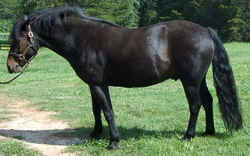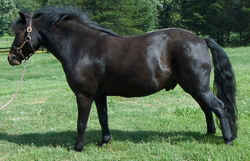 |
 |
Welsh Pony - Shetland Cross
 |
 |
Welsh Pony: There are three different types of Welsh Pony: the Welsh Mountain Pony, the Welsh Pony and the Welsh Pony of Cob Type. The Welsh Mountain Pony is the smallest of the three. It is also the oldest, thought to descend from the ancient Celtic ponies. It evolved in the hills of Wales before the Romans inhabited that area. The Welsh Pony is very much like the Welsh Mountain Pony, only larger, having been outcrossed with Hackney and a small Thoroughbred stallion named Merlin. The Welsh Pony of Cob Type is of a much heavier build than the others. As a result, it makes an excellent trekking mount and a great all-round riding and driving pony. The Cob Type was developed with the help of the Andalusian, Welsh Cob and Welsh Mountain Pony. Description: All three ponies are very similar, except that the Cob Type is generally more stocky and robust than its lighter and smaller cousins, and there are some color variations. They have small heads with large wide-set eyes and small, pricked ears; profile either slightly dished or straight; neck arched and well set on sloped shoulders; back short, with a slightly sloping croup; girth deep; legs strong, with short cannon bones; hooves hard and round; color solid. Welsh and Welsh Cob Type Ponies are also solid in color, although piebald and skewbald are also seen. [Grove, Kindrie, Field Guide to Horses, Lone Pine Publishing, Edmonton, Alberta, 1998]
Shetland: Often known as 'Scotland's Little Giant,' the Shetland is the smallest pony breed. Its origins are believed to stem from the ponies of Scandinavia, Ireland and Wales, which must have traveled to the Shetland Islands off the coast of Scotland before the lands separated. They were subsequently brought to Scotland by the Celts. Shetlands were used extensively in the coal mines of Europe, where it was difficult for even a small child to stand up straight. Description: Evolving in the harsh weather of Scotland and Scandinavia, Shetlands are extremely hardy and long lived. They are also very strong, able to carry half of their body weight. Today Shetlands make excellent children's mounts, as long as the ponies are not spoiled. The American Shetland is a common sight in both the United States and Canada. Shetlands are stout and lively. The head is small with large, kind eyes and small ears and muzzle; neck short and thick; back small and hard; mane and tail thick and very long; winter coat also very long and dense; color varies, including piebald and skewbald. [Grove, Kindrie, Field Guide to Horses, Lone Pine Publishing, Edmonton, Alberta, 1998]
Horses * Horse Books * Mules * Nature Lovers